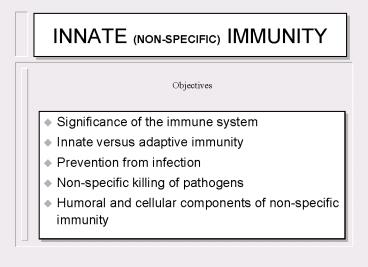INNATE NONSPECIFIC IMMUNITY - PowerPoint PPT Presentation
1 / 26
Title:
INNATE NONSPECIFIC IMMUNITY
Description:
A lag period. Antigen specific. Development. of memory. Innate Immunity ... T and B lymphocytes. Effector mechanisms in Innate Immunity -1. Peristalsis, low pH ... – PowerPoint PPT presentation
Number of Views:184
Avg rating:3.0/5.0
Title: INNATE NONSPECIFIC IMMUNITY
1
INNATE (NON-SPECIFIC) IMMUNITY
Objectives
- Significance of the immune system
- Innate versus adaptive immunity
- Prevention from infection
- Non-specific killing of pathogens
- Humoral and cellular components of non-specific
immunity
2
Prevention from Infection
3
Significance of the Immune System
- Beneficial
- Protection from Invaders
- Elimination of Altered Self
- Detrimental
- Discomfort (inflammation)
- Damage to self (autoimmunity)
4
Characteristics of Innate and Adaptive Immunity
Innate Immunity
Adaptive Immunity
- Antigen independent
- Antigen dependent
- No time lag
- A lag period
- Not antigen specific
- Antigen specific
- No Immunologic
- memory
- Development
- of memory
5
Components of Innate and Adaptive Immunity
Innate Immunity
Adaptive Immunity
physical barriers
skin, gut Villi, lung cilia,etc
none
soluble factors
many protein and non-protein secretions
Immunoglobulins (antibody)
cells
phagocytes, NK cell eosinophils, K cells
T and B lymphocytes
6
Effector mechanisms in Innate Immunity -1
Site Component Mechanisms
7
Effector mechanisms in Innate Immunity -2
Site Component Mechanisms
8
Effector mechanisms in Innate Immunity -3
Site Component Mechanisms
9
Phagocytes are the Most Important Cells
10
All phagocytes eat, digest and extrude
11
The two Phagocytes Neutrophils
- phagocytosis, intracellular killing, inflammation
and tissue damage - characteristic nucleus, cytoplasm
- granules and CD67 membrane marker.
12
The two PhagocytesMacrophages
- phagocytosis, intracellular and extra-cellular
killing, tissue repair, antigen presentation for
specific immune response - characteristic nucleus and CD14 membrane marker.
13
Characteristics of Neutrophil Granules
Primary granules
Secondary granules
azurophilic characteristic of young neutrophils
specific for mature neutrophils
contain cationic proteins, lysozyme, defensins,
proteases and myeloperoxidase
contain lysozyme, NADPH oxidase, lactoferrin and
B12-binding protein
14
Phagocyte Response to Infection
- The SOS Signals
- N-formyl methionine
- Clotting system peptides
- Complement products
- Phagocyte response
- Vascular adherence
- Diapedesis
- Chemotaxis
- Activation
- Phagocytosis and killing
15
Initiation of Phagocytosis
Attachment via
16
Respiratory Burst
Oxygen Dependent Myeloperoxidase Independent
Reactions
17
Respiratory Burst
Oxygen Dependent Myeloperoxidase dependent
reactions
18
Pathways of Intracellular Killing
19
Mediators of Oxygen Independent Killing in the
Phago-lysosomes
20
Nitric Oxide Dependent Killing
21
Non-specific Killer Cells
- NK and LAK cells
- K cell
- Activated
- macrophages
- Eosinophils
- They all kill foreign and altered self targets
22
Natural Killer (NK) cells
- also known as large granular lymphocytes (LGL)
- kill infected and malignant cells
- are identified by the presence of CD56 CD16 and
absence of CD3 - activated by IL2 and IFN-? to become LAK cells
23
Lymphokine Activated Killer (LAK) cell
IFN
IFN
IL2
IL2
24
K Cells
- morphologically undefined
- have IgG Fc receptor
- recognize antibody coated targets
- could be NK cells (IgG), macrophages (IgG),
eosinophils (IgE) or other cells (IgG)
25
Macrophages
- phagocytose kill intracellularly
- identified by CD14
- adherent of plastic and glass surfaces
- activated by cytokines
- kill both intracellular organisms
- kill malignant and altered self targets
26
Elements of Nonspecific Immunity
- Physical Barriers
- skin, muco-ciliary escalator, secretions,
peristaltic movement, etc. - Cells
- pagocytes
- Oxygen-independent killing
- O2-dependent-MPO independent killing
- O2-dependent-MPO dependent killing
- Nitric Oxide mediated killing
- cytotoxic cells
- NK, LAK, K (ADCC)































